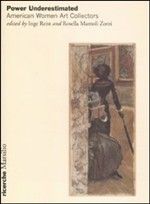POWER UNDERESTIMATED
American Women Art Collectors
edited by Rosella Mamoli Zorzi, Inge Reist
Marsilio, 04/05/2011
collana "Ricerche"
The history of American art collectors, both men and women, has been the subject of several studies in recent years, yet many signifi cant fi gures have yet to receive the attention they deserve. This volume offers new insights into the attitudes of several women collectors whose approaches to art collecting help us measure the temper of the times in which they lived. Complementing this are essays that examine how America’s leading authors of the Gilded Age, Henry James and Edith Wharton, illuminated the world of art collecting.
The title of the book emphasizes the fact that many of the subjects of the essays were highly effective cultural leaders, undaunted, even at times underestimated, by the men who dominated the worlds of art, politics and cultural philanthropy. The essays trace the activities of women collectors and patrons immediately following the end of the Civil War through the Gilded Age to the end of the twentieth century. Included are essays about such pioneering fi gures as Milwaukee-based Martha Mitchell and her “Art Sisterhood” with Elizabeth Greatorex and others; New York socialite Mrs. Paran Stevens, known as the model for one of Wharton’s characters; Catharine Lorillard Wolfe, the only female founder of The Metropolitan Museum of Art; the enigmatic Arabella Huntington, wife of both Collis and Henry Huntington, and a major force in forming the collections that bear their names; Irene Leache and Annie Wood, the original creators of what would become the Chrysler Museum; Helen Clay Frick, daughter of the founder of The Frick Collection and a woman whose taste showed remarkable independence, even as she strove to honor her father in her collecting and philanthropic activites; Lillie Bliss, one of the founders of the MoMA, who eschewed public recognition or praise; and Doris Duke, the reclusive heiress, whose legacy to collecting and aesthetic individualism rests in her fascinating Islamic-inspired home in Honolulu.
This variegated and exciting world of art collecting caught the imagination of two great American writers, Henry James and Edith Wharton, some of whose works recreated it imaginatively and are explored in three of the essays in this volume.
Two institutions contributed to the symposium from which this book originated, the vibrant Center for the History of Collecting in America, at The Frick Collection, New York, directed by Inge Reist, and the Doctoral School in Languages, Cultures and Societies of the University of Venice, Ca’ Foscari, directed by Rosella Mamoli Zorzi.
American Women Art Collectors
edited by Rosella Mamoli Zorzi, Inge Reist
Marsilio, 04/05/2011
collana "Ricerche"
The history of American art collectors, both men and women, has been the subject of several studies in recent years, yet many signifi cant fi gures have yet to receive the attention they deserve. This volume offers new insights into the attitudes of several women collectors whose approaches to art collecting help us measure the temper of the times in which they lived. Complementing this are essays that examine how America’s leading authors of the Gilded Age, Henry James and Edith Wharton, illuminated the world of art collecting.
The title of the book emphasizes the fact that many of the subjects of the essays were highly effective cultural leaders, undaunted, even at times underestimated, by the men who dominated the worlds of art, politics and cultural philanthropy. The essays trace the activities of women collectors and patrons immediately following the end of the Civil War through the Gilded Age to the end of the twentieth century. Included are essays about such pioneering fi gures as Milwaukee-based Martha Mitchell and her “Art Sisterhood” with Elizabeth Greatorex and others; New York socialite Mrs. Paran Stevens, known as the model for one of Wharton’s characters; Catharine Lorillard Wolfe, the only female founder of The Metropolitan Museum of Art; the enigmatic Arabella Huntington, wife of both Collis and Henry Huntington, and a major force in forming the collections that bear their names; Irene Leache and Annie Wood, the original creators of what would become the Chrysler Museum; Helen Clay Frick, daughter of the founder of The Frick Collection and a woman whose taste showed remarkable independence, even as she strove to honor her father in her collecting and philanthropic activites; Lillie Bliss, one of the founders of the MoMA, who eschewed public recognition or praise; and Doris Duke, the reclusive heiress, whose legacy to collecting and aesthetic individualism rests in her fascinating Islamic-inspired home in Honolulu.
This variegated and exciting world of art collecting caught the imagination of two great American writers, Henry James and Edith Wharton, some of whose works recreated it imaginatively and are explored in three of the essays in this volume.
Two institutions contributed to the symposium from which this book originated, the vibrant Center for the History of Collecting in America, at The Frick Collection, New York, directed by Inge Reist, and the Doctoral School in Languages, Cultures and Societies of the University of Venice, Ca’ Foscari, directed by Rosella Mamoli Zorzi.
